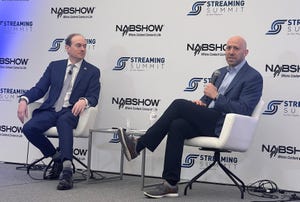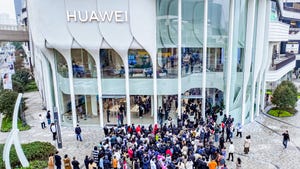The optical community was buzzing at this year's OFC event, fueled in part by 5G expectations and developments from the likes of Ciena, Coriant, Infinera, Nokia and NeoPhotonics.
April 2, 2018

It's been a couple of years since I attended the annual California-based OFC (Optical Fiber Communication) conference but I'm very glad I attended this year's event in San Diego.
Why? Well, apart from being in California in March instead of northern Europe (a "no-brainer" as the kids used to say in the last century), it's because OFC is to optical as Mobile World Congress is to mobile -- OFC is where the optical communications community goes every year.
And it's growing, in terms of people, floor space and buzz. You can count people and measure floor space, but buzz is less quantifiable. However, having been to more industry gatherings than I care to admit, I believe I can sense when there is genuine optimism and expectation and that's what I got in San Diego (and before anyone asks, that wasn't just a quadruple espresso coursing through my chassis).
Figure 1:  I kid you not... that was a quad shot. About 20 minutes later I spent $100 on second-hand CDs and then collapsed on a park bench...
I kid you not... that was a quad shot. About 20 minutes later I spent $100 on second-hand CDs and then collapsed on a park bench...
My gut tells me there could be a few bright years ahead for the developers of optical and Ethernet networking tech.
There are two main reasons. Data center traffic volumes are going through the roof, driving demand not only for the technology that enables data packets to be networked within those centers -- a broad range of 400G chips, components and modules were on display at OFC, noted Ian Redpath, Ovum's practice leader of components, transport and routing, in an OFC note (registration required) -- but also between: Data center interconnect (DCI) is hotter than ever, which is good news for the systems vendors. (See Cisco: Data Centers Are Eating the Internet and DCI Market to Reach $1B by 2019.)
The second reason is 5G, for the basic reason that the promised land of Gigabit-plus mobile broadband and ultra low-latency applications (industrial IoT, virtual reality and so on) cannot be reached unless there is an upgraded, intelligent optical transport foundation underpinning the whole 5G premise.
That's my view, at least, but the OFC crowd was given a taste of what network operators with 5G aspirations might need in the coming years when Chengliang Zhang, Vice President of China Telecom Beijing Research Institute, gave a plenary speech that laid out the potential demands of a 5G architecture: A much more dense radio access network based on a Cloud RAN (CRAN) design supported by low latency and significant capacity in fronthaul, mid-haul and backhaul links, which in turn requires greater support from metro, regional and long-distance networks. All of this, he noted, will require extensive optical transport investments. (See An Optical Transport Vision for the Cloud, 5G Era.)
Figure 3:  Chengliang Zhang from the China Telecom Beijing Research Institute can's see how building 5G networks won't demand extensive optical transport investments... and I think he's right.
Chengliang Zhang from the China Telecom Beijing Research Institute can's see how building 5G networks won't demand extensive optical transport investments... and I think he's right.
In addition, Chi-Min Lo, Deputy MD in the Engineering Dept. at Chunghwa Telecom, noted during a presentation at the Nokia stand that the Taiwanese operator was anticipating a "lot of bandwidth-hungry demands" in the coming years, particularly in relation to 5G fronthaul and backhaul.
Figure 2:  Chunghwa Telecom's Chi-Min Lo plans to prep his network for those bandwidth-hungry applications that come with the arrival of 5G.
Chunghwa Telecom's Chi-Min Lo plans to prep his network for those bandwidth-hungry applications that come with the arrival of 5G.
And during the OIDA (OSA Industry Development Associates) Executive Forum, run by the Optical Society, Verizon's VP of Network Planning, Lee Hicks, provided an overview of how the operator plans to deal with the demands of 5G, cloud and capacity-crunching applications by building out its Intelligent Edge Network (the iEN). That includes the deployment of NG-PON2 access technology with integrated BNG (broadband network gateway) functionality housed in the "central office of the future" that incorporates "shared edge facilities" to be used by all Verizon business units, whether for 5G fronthaul or enterprise/residential broadband services. (See Verizon, Calix Deploy Commercial NG-PON2 .)
The rest of the week was peppered with references to the demands 5G will place on transport networks, with presentations by executives from BT and Deutsche Telekom during the ON2020 session entitled "Industry Visions for a Converged Optical Networking Roadmap" just one more example. (See Looking to the Future With ON2020: An OFC Perspective.)
So what is the optical technology sector doing to meet the needs of the web-scale giants, other data center players and network operators? Well, the era of 600 Gbit/s transport is almost upon us and could squeeze the window of opportunity for 400-Gbit/s deployments, noted Heavy Reading's optical transport systems guru Sterling Perrin when he spoke with me on the OFC show floor:
So who's actually talking now about 600G? Among the systems vendors, Coriant, Nokia and Infinera are making a case with their latest product developments, the Groove G30, Photonic Service Engine 3 (PSE-3) and ICE5 respectively. (See Coriant Claims Industry Benchmarks With Its Groove G30, Infinera Shifts Up a Gear With Its Latest Optical Engine and Nokia Pushes Optical to the Limit.)
ADVA, though, was talking about 600G in its DCI platform a year ago, it should be noted. (See ADVA Sets 600G Benchmark.)
And it's "still DCI that's the main driver" of interest and business, noted ADVA's VP of Technical Marketing Michael Ritter. In addition to the need for greater capacity on existing inter-DC routes, data centers are becoming more distributed, adding to the need for dedicated systems that are efficient from an operational and cost perspective, he added.
And in terms of industry trends, they developments are in the 400G and 600G component space. "That's what people are here to look at," he noted.
And there was a lot to look at -- the show floor has grown in the past few years, that's for sure but it wasn't hard to find the larger-than-life figure that is John D'Ambrosia, a major figure in the Ethernet world and, these days, working at the FutureWei unit of Huawei. When I met with him, and we were both pumped to the gills with caffeine, he told me how the industry is about to hit some pretty amazing Ethernet milestones:
And, of course, there was some major M&A optical component activity during the show that helped fuel the buzz. Oclaro had been identified as a takeover target for some time but the industry had expected Finisar to splash its cash -- instead, Lumentum stepped in for what was generally regarded as a positive move. (See Lumentum Sweeps Up Oclaro in $1.8B Deal.)
So, a lot going on. But there's more! I spoke to a number of companies during and after the event, including Ciena, Coriant and Neophotonics, and eyeballed the latest move from hot startup Sedona.
Next page: Ciena goes deep, Coriant smells automation
Ciena goes deep
With the cable operator sector in full flow with 'Fiber Deep' strategies, Ciena rightly supposes there will be more need for data traffic aggregation and backhaul capacity at the edge of MSO networks. (See Why Cable's Feasting on Fiber.)
For aggregation, it's targeting the cable community with its 8180 Coherent Networking Platform, a dense packet switch with coherent optics (incorporating its WaveLogic Ai processor) that "could be very attractive in fiber deep" scenarios, stated Helen Xenos, senior director of portfolio marketing at the vendor. (See Ciena Unveils New Products at OFC.)
Ciena also unveiled its 6500 Reconfigurable Line System (RLS), a new system designed for data center interconnect, metro transport and backhaul applications. "There are hundreds of thousands of fiber pairs that are filling up fast and operators want scalable and simple-to-use systems that can also help get power usage down," noted Xenos. Ciena says both new systems have open APIs to enable automated configuration, SDN control and to enable streaming telemetry, an important feature for programmable and autonomous network management.
Both systems will be commercially available during the second half of the year, with customer trials soon for the 6500 RLS and in the third quarter for the 8180.
Figure 4:  Ciena has its eyes on the Fiber Deep strategies of cable operators.
Ciena has its eyes on the Fiber Deep strategies of cable operators.
Xenos said Ciena has already been selected for deployment in two "Fiber Deep opportunities with cable operators."
The Ciena was also taking an interested look at the Lumentum/Oclaro M&A news, as both of those companies were two of the three optical components specialists that signed up last year to build products around Ciena's WaveLogic Ai chip, the other being NeoPhotonics. (See Ciena Sets Its WaveLogic Free.)
Xenos says Ciena has been "shipping units for integration" and that revenues are expected from those agreements later this year. But with two of those partners combining, are there any further opportunities to get the WaveLogic Ai chip out to market through additional channels? "There are other conversations but nothing determined yet," is all Xenos would say.
Coriant spies automation, edge interest
Optical systems vendor Coriant rolled into OFC with an upgraded platform, the Groove G30, and a very interesting trial of optical network management, including dynamic provisioning, with Telia Carrier. (See Coriant Claims Industry Benchmarks With Its Groove G30 and the fourth item in this EMEA news roundup.)
During the event, Rob Shore, a Senior VP at the vendor, noted there was an "increased interest among operators in network automation and SDN/NFV" compared with a year ago. "Operators have begun deployments of wider scale implementations and are recognizing the benefits of things such as open and modular approaches to SDN," he noted.
Edge compute is also featuring as a strategic topic. "It was clear from our customer engagements that edge compute stands out as a key trend that will have a strong impact on multiple layers of the network, including the optical layer. Customers are keen to deploy edge compute capabilities quickly and cost-efficiently, as the potential for service differentiation in emerging areas such as 5G and IoT is seen as significant," added the Coriant man. (And there's 5G again...)
Figure 5:  Automation featured prominently in Coriant's customer chats at OFC.
Automation featured prominently in Coriant's customer chats at OFC.
And, of course, "we continue to see strong interest in higher capacity and more flexible optical transmission -- 400G, 600G, programmable modulation -- as customers look for ways to get the most of their deployed fiber assets at the lowest cost-per-bit of transmissions while keeping pace with bandwidth growth. We heard this consistently from our web-scale, cable/MSO and service provider customers," stated Shore.
And having "realized the value of disaggregation in the optical layer, where the open networking trend is now firmly rooted, we're seeing more and more interest from operators in extending disaggregation into the IP/routing layer to achieve the same benefits, including lowering cost and leveraging faster innovation cycles and best-in-class functionality, while breaking vendor lock-in." Those operators would have been interested in Cisco's news this week, then. (See Cisco Bows to Carrier Demand for Software Outside the Box.)
NeoPhotonics -- pushing boundaries
Always a significant presence at the show, photonic integrated circuit specialist NeoPhotonics rolled into San Diego to show off its 64 Gbaud Coherent Optical Sub-Assembly (COSA) product that, with its very small size (I had to almost squint to see it) is right in the ballpark for 400G and 600G system development and, according to Ferris Lipscomb, VP of marketing, suited for both data center and DCI applications.
So surely there's only so much smaller these components can get? "We're getting to the physical limits," noted Bueller Lipscomb.
And as the components enable even greater capacity while getting smaller, the trend towards disaggregation will likely get stronger, reckons the NeoPhotonics man. "The web-scale companies will be able to develop things by themselves and not buy from the system vendors," he suggests, though that's already been tried with limited success in some quarters.
While NeoPhotonics waits for that wave, and for demand for the 64 Gbaud COSA to develop, it's still successfully shipping 100G and 200G products to customers such as Huawei and Ciena. And the good news for the company, notes Lipscomb, is that the key market of China, following a recent hiatus, appears to be returning. "Inventories have been used up," he noted.
Of course there were many other companies, many other announcements during the show. One of the hottest startups in the industry, Sedona Systems , unveiled its new hierarchical network controller that shows what's possible in terms of multi-layer, multi-domain, multi-vendor network management. No wonder it's attracting interest and support. (See Sedona Unveils New NetFusion Hierarchical SDN Controller , Verizon Turns to Sedona for Transport SDN Management & Automation Smarts and Verizon Deployment Will Trigger Bids for Sedona – Analyst.)
Figure 6:  NeoPhotonics is approaching the physical limits of shrinkage...
NeoPhotonics is approaching the physical limits of shrinkage...
There's little doubt in my mind that the opportunities for the optical and packet networking communities will only get richer in the next few years: Of course, what'll be interesting will be identifying which companies reap the benefits and those that fall by the wayside.
And having taken the industry's temperature at the NGON & DCI event in Nice in late June, and ECOC in Rome in the fall, I'll be back at OFC next year to see how things have heated up… or cooled down.
— Ray Le Maistre, Editor-in-Chief, Light Reading
You May Also Like









